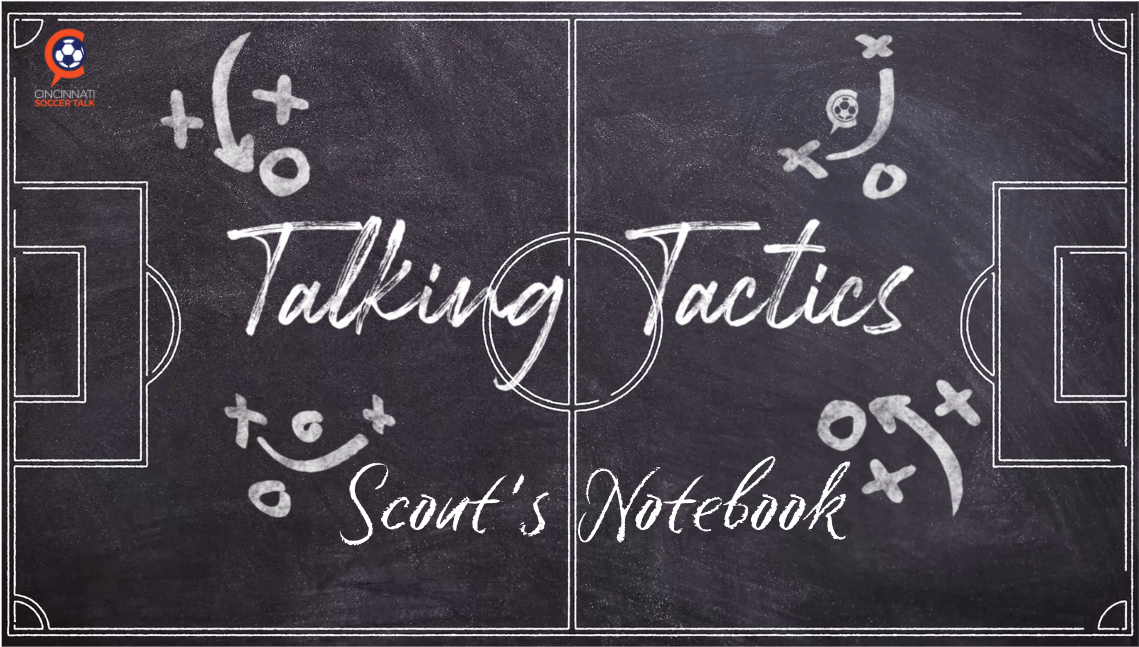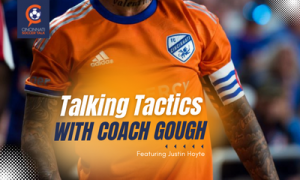Each week on The Walkthrough, Nate Gilman and I give you a high-level look at key tactical ideas for the upcoming match. To come up with those ideas, I watch at least two recent matches and compile the type of scouting report that I would have had for an opponent when I was coaching. I thought I’d give you all a peek behind the curtain by publishing that report. Let me know what you think and if I should keep these articles coming (@FCCincyTacTalk).
Team: Inter Miami CF
Matches Scouted: 3/20/23 vs. Chicago Fire and 3/13/23 at Toronto FC
Formation: 4-2-3-1
Mode of Attack
Inter Miami CF begins nominally in a 4-2-3-1 formation. Lately, Rodolfo Pizzaro has been starting on the wing, but drifting inside, looking to get on the ball. This allows the left back to push high while one of their midfielders in the double pivot (typically Jean Mota) drops deep to pull the strings. The formation tends to look more like a 3-4-2-1 in possession.
The Herons try to use the ball by building from the back in what I like to call a pass-and-probe. They work the ball around the back, playing into a midfielder and immediately back out, in hopes of unbalancing the defense. From there, they like to play line-splitting passes to their central attacking midfielder or Pizarro pinched in from the wing. Often, if this is not on, they will look to play long to a forward running the channels.
Method of Chance Creation
Once Inter Miami has gotten the ball into the final third, they typically attack from the outside. When the ball is played centrally, it is typically knocked back to the outside quickly. Their main method of chance creation is utilizing two-on-one combination play down the wing, then crossing or looking for cutbacks.
Mode of Defense
Though their formation is a 4-2-3-1, Inter Miami looks to form two banks of four when they defend. That means that they have a flat back four and a flat midfield four. They try to play very compact and narrow. Often, when the ball is all the way wide, their entire defending team will be on the ball side of the pitch. This makes them susceptible to quick switches of play.
Once in their two banks of four, the Herons try to move forward as a team and constrict space. Their center backs are aggressive stepping into the midfield to try to win tackles. When their lines get stretched and there is a lot of space between their midfield and back four, their central midfielders and center backs have a difficult time rotating to keep opponents from exploiting it.
Mode of Transition
Offensively Inter Miami does not typically try to transition quickly. They like to ease into possession by keeping the ball. In the rare cases where they do go forward quickly, it is typically on the dribble. If they pass it to a target, they will look for a quick touch to an open player to drive forward on the dribble.
Defensively, they do not typically press. They also don’t drop into a mid-block. They typically try to get to their defensive shape and set a high line of confrontation from which to constrict space. This means that teams that can transition quickly before they set themselves should find space.
Major Strenghts
- Jean Mota has a fantastic left foot. If he is given time and space, he can hit a pass to any part of the pitch. He is particularly dangerous hitting a long diagonal from right to left. He also is capable of coming inside from the right half-space and shooting from distance.
- Inter Miami is also very good at combination play up the line. Pizarro is crafty and uses the drop of a shoulder to create space to slip players in behind the defense on the outside.
Vulnerabilities
- Without the injured Gregore, the Inter Miami midfield can be slow to rotate, providing lots of room between the lines for the opponent. They also struggle to track midfield runners to the corners.
- The Heron center backs like to try to win tackles in the midfield but are often a step late. This means that they are susceptible to combination play off a target striker.
- In both matches that I scouted, the team appeared to have difficulty defending set pieces that were hit to the back post.



















